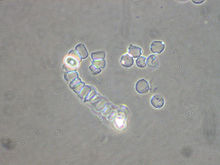| Acrasid slime molds | |
|---|---|

| |
| Acrasis rosea | |
| Scientific classification | |
| Domain: | Eukaryota |
| Clade: | Discoba |
| Superphylum: | Discicristata |
| Phylum: | Percolozoa |
| Class: | Heterolobosea |
| Order: | Acrasida |
| Family: | Acrasidae van Tieghem 1880 ex Hartog 1906 |
| Genera | |
| Synonyms | |
| |

The family Acrasidae (ICZN, or Acrasiomycota, ICBN) is a family[1] of slime molds which belongs to the excavate group Percolozoa. The name element acrasio- comes from the Greek akrasia, meaning "acting against one's judgement". This group consists of cellular slime molds.
The terms "Acrasiomycota" or "Acrasiomycetes" have been used when the group was classified as a fungus ("-mycota"). In some classifications, Dictyostelium was placed in Acrasiomycetes, an artificial group of cellular slime molds, which was characterized by the aggregation of individual amoebae into a multicellular fruiting body, making it an important factor that related the acrasids to the dictyostelids.[2]
Each cell keeps its individuality even when it forms a stalk and fruiting body to reproduce.[3] Slime molds were originally thought to be in a monophyletic group Mycetozoa, with little distinction between Acrasis and Dictyostelids, however scientists uncovered that they were distinct groups, and eventually that Acrasis was incredibly distant on the tree of life. Instead, it is found in Heterolobosia with Naegleria, away from other myxamoeba.[4]
- ^ Roger AJ, Smith MW, Doolittle RF, Doolittle WF (1996). "Evidence for the Heterolobosea from phylogenetic analysis of genes encoding glyceraldehyde-3-phosphate dehydrogenase". J. Eukaryot. Microbiol. 43 (6): 475–85. doi:10.1111/j.1550-7408.1996.tb04507.x. PMID 8976605.
- ^ Cavender J.C.; Spiegl F.; Swanson A. (2002). "Taxonomy, slime molds, and the questions we ask". The Mycological Society of America. 94 (6): 968–979. PMID 21156570.
- ^ Brown, M. W.; Silberman; Spiegel (2010). "A Morphologically Simple Species of Acrasis (Heterolobosea, Excavata), Acrasis helenhemmesae n. sp". Journal of Eukaryotic Microbiology. 57 (4): 346–353. doi:10.1111/j.1550-7408.2010.00481.x. PMID 20497285.
- ^ Brown, M. W.; Kolisko, M.; Silberman, J. D.; Roger, A. J. (2012). "Aggregative Multicellularity Evolved Independently in the Eukaryotic Supergroup Rhizaria". Current Biology. 22 (12): 1123–1127. Bibcode:2012CBio...22.1123B. doi:10.1016/j.cub.2012.04.021. PMID 22608512.